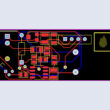The inverter converts DC voltages to AC voltages to provide power to electronic devices.
Hardware Components:
| 1. | Capacitor 1000uF | x1 |
| 2. | Resistor 330 ohm | x1 |
| 3. | Resistor 390k ohm | x1 |
| 4. | Resistor 1k ohm | x1 |
| 5. | Resistor 220 ohm | x2 |
| 6. | LED | x1 |
| 7. | IRFZ44NPBF | x2 |
| 8. | Connector Terminal 2 pins | x1 |
| 9. | Connector Terminal 3 pins | x1 |
| 10. | CD4047BM96 | x1 |
| 11. | Capacitor 10nF | x1 |
| 12. | Potentiometer 100k ohm | x1 |
Software Tools:
- Inventhub
- Altium Designer
Introduction to Inverter:
Inverters are those electrical devices that convert DC voltages to AC voltages. It is used to provide power to the other electrical devices that use an AC supply. These are used as backup power for the devices in case of a power outage. The household appliances use an AC supply of different voltage levels to work. In case of a power outage, UPS installed in the houses starts to work. They have a DC battery but the appliances work on AC supply. Here the inverter performs the conversion from DC to AC and provides power to the electrical devices. This inverter converts 12V DC voltages to 220V AC voltages. They are also used for solar backup and Air conditioning systems. Inverters are the fundamental building block for SMPS (Switch mode power supply).
Types of Inverters:
- Pure Sine Wave Inverter
- Modified Sine Wave Inverter
IC CD4047:
The CD4047 consists of an astable multivibrator (the state in which the circuit is not stable, continually switches from one state to the other). It is a low-power CMOS with a 50% duty cycle. This is used to switch from DC to AC. Its applications include frequency division, multiplication, discriminators, Timing circuits, and Timing delay.
Design files:
I have created a schematic diagram in Altium then I uploaded my schematic file online on Inventhub. Users can view or download the schematic file. They do not need to create symbols and footprints instead they can easily download them from components management library on Inventhub to implement my design.
In the PCB file, I can design my board and can view it in 3D. I have uploaded my PCB file on Inventhub where I can view my board in different layers and can focus on a specific layer of a board by disabling others.
Release file:
I have created a release of my project on Inventhub. Users and manufacturers can visually view and download my design in a ZIP file format. For the manufacturers, this file is very useful they do not need to check and download each file separately they can download all the design files in one folder. Thus, the board can be manufactured easily without any error.
Project History:
While creating my PCB board in Altium I have committed different versions of my design on Inventhub after every change I have made in my design. I can view the history of my project with different changes. If I want to get back a particular change I have made, I can go to the revisions of my project on Inventhub and can download that file. It is acting as backup files of my project.
Bill of Materials:
I have created a list of components on Inventhub with all details like manufacturer, supplier, quantity, price, and manufacturer part number. I have also calculated the estimated price of my components which is approximately $10. Instead of visiting my component provider, I can send him this file, he can download it in CSV file format and can deliver my components.
To get complete how-to and detailed information on the project design and implementation visit this link:








